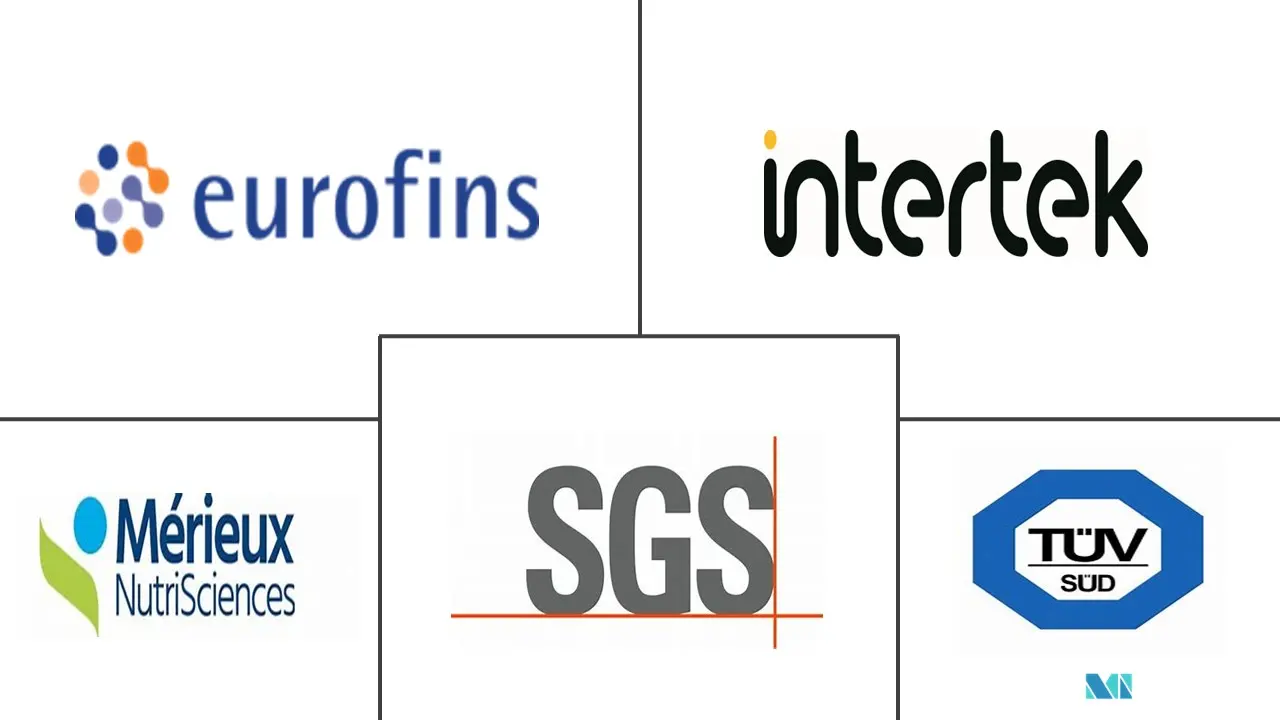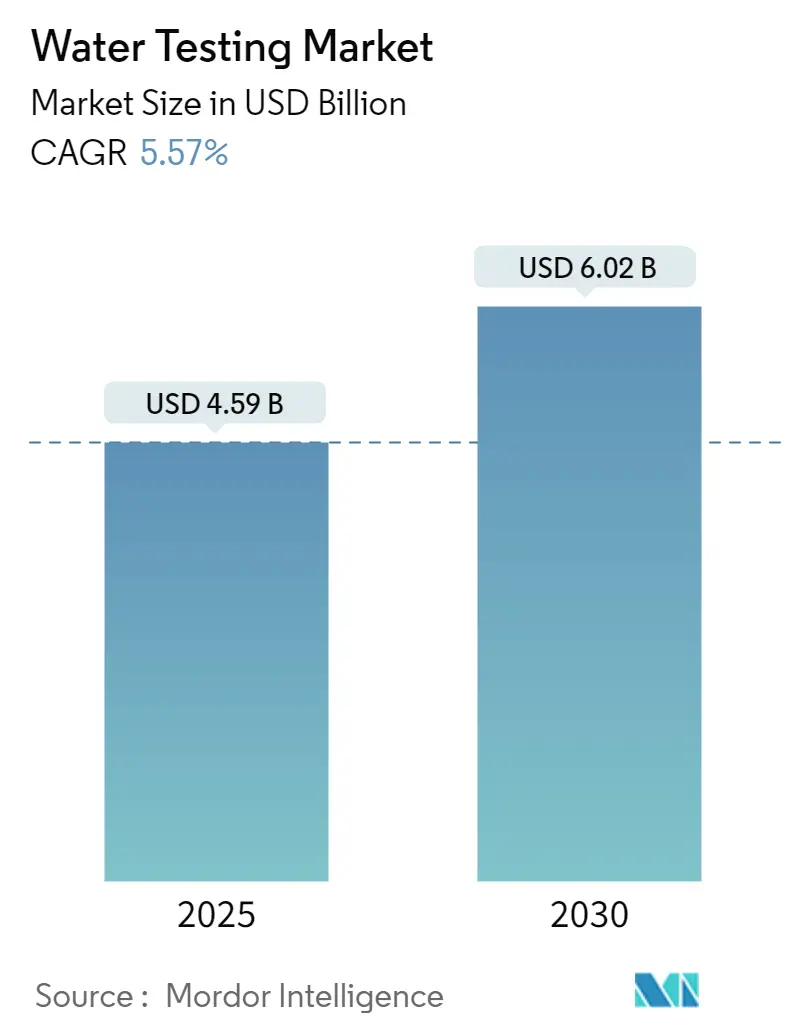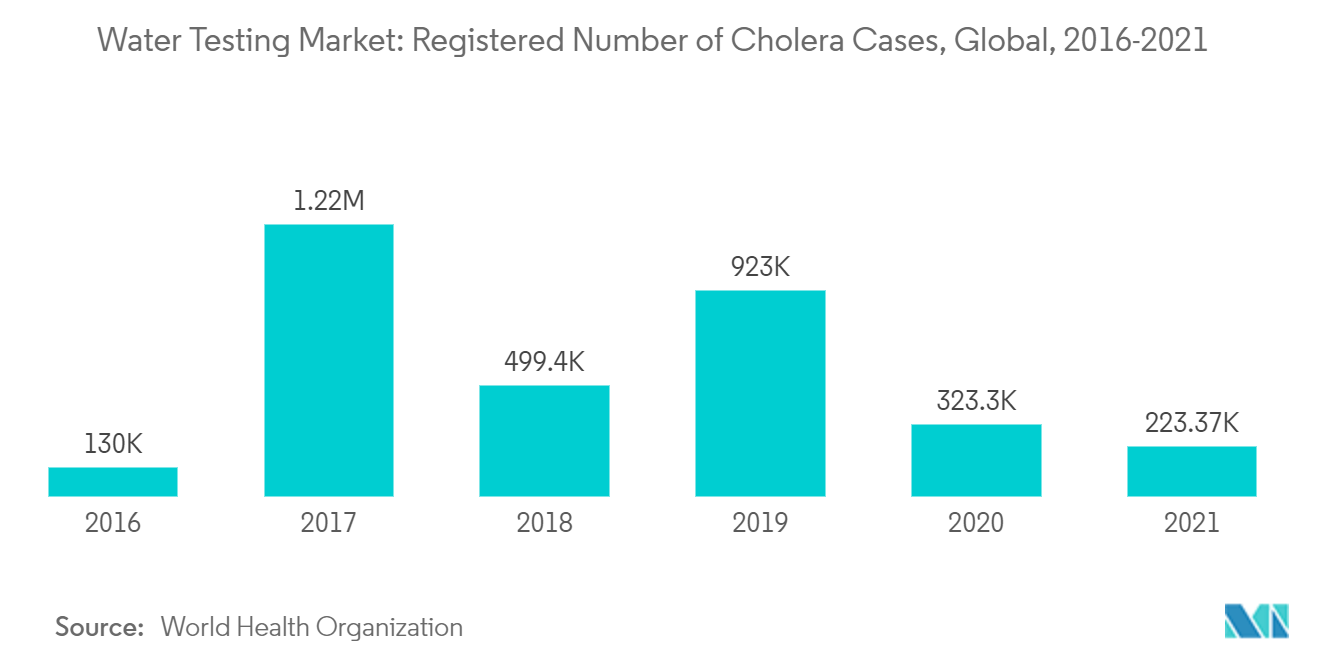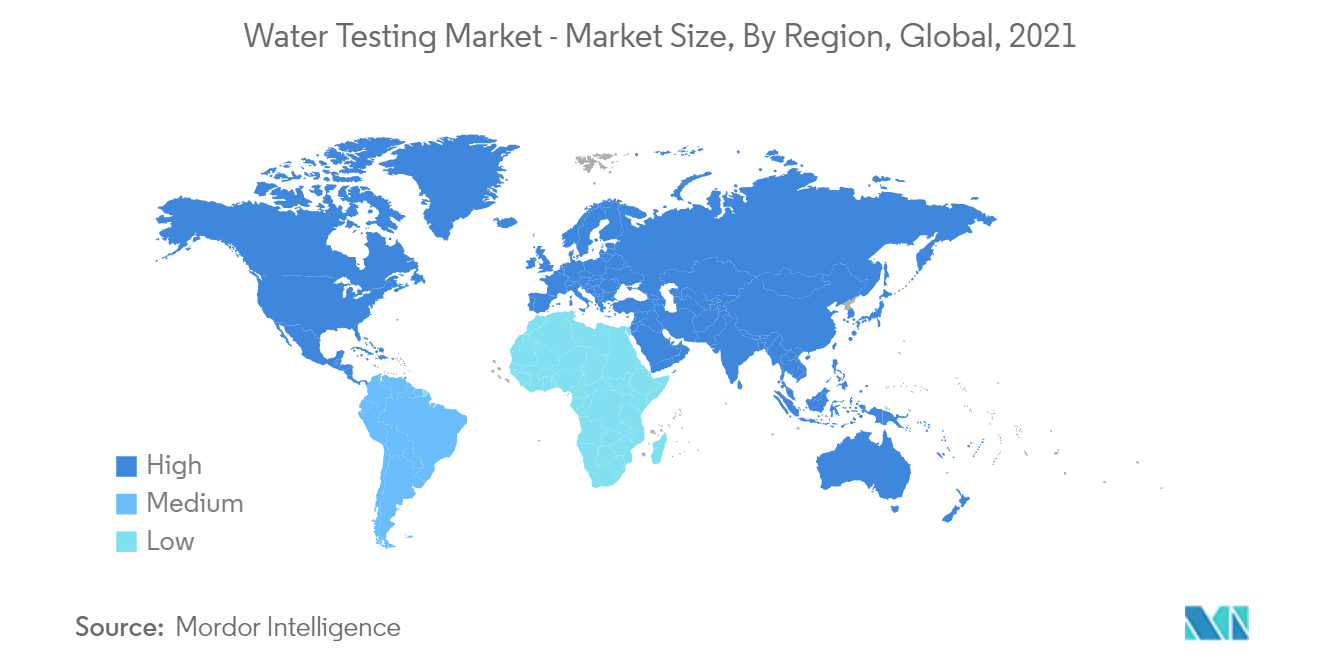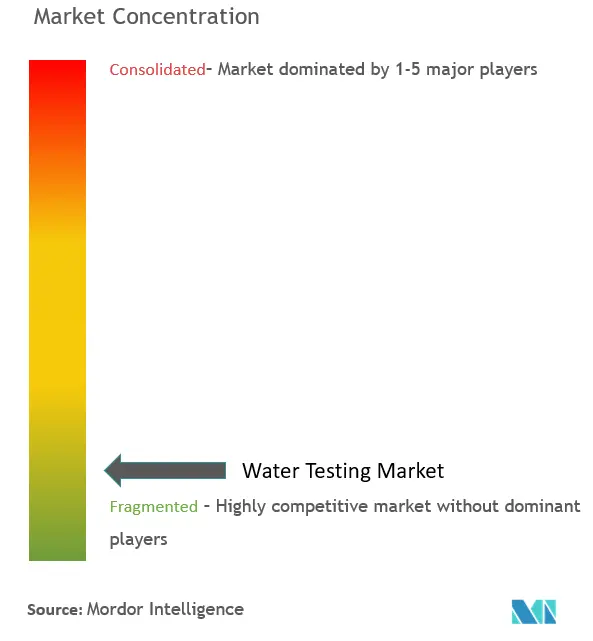Water Testing Market Analysis
The Water Testing Market size is estimated at USD 4.59 billion in 2025, and is expected to reach USD 6.02 billion by 2030, at a CAGR of 5.57% during the forecast period (2025-2030).
- The COVID-19 pandemic had a significant impact on the global water testing market as it affected consumers' lifestyles and increased their chances of spreading coronavirus. Thus, the water and supply chain industries were impacted as consumers became more concerned regarding the security and safety of water-based products. Additionally, in the wake of the pandemic, government bodies, agencies, and Non-Government Organizations have also been contributing significantly to the rising demand for safety across the country.
- For instance, during the time of this pandemic, the United States Food and Drug Administration (FDA) and Federal Trade Commission (FTC) have been closely watching for misleading product claims around COVID-19 prevention or treatment, and even a general 'immunity' claim on a product can be considered an implied claim about COVID-19.
- Over the long term, in developing countries like India, consumable water is expected to be safe and of high nutritional value due to increasing consumer awareness. The rise in consumption of bacteria- and chemical-free water is driving the demand for water testing equipment across the globe.
- Additionally, rising incidences of water-borne diseases, such as typhoid, dysentery, and cholera, are playing a major role in market growth. According to the World Health Organization (WHO), in 2022, approximately 8,29,000 people per year die from diarrheal disease as a result of poor hand hygiene, sanitation, and drinking water. However, diarrhea is largely preventable, and if these risk factors are addressed, infant deaths under the age of five per year may be averted, which is expected to be one of the key drivers for the market over the forecast period.
- Furthermore, the increasing regulatory support and legislation for high standard maintenance of food and beverage products, pharmaceuticals, and other industries, are further increasing the applications of chemically te/sted water. For instance, with the passage of the Food Safety Modernization Act and the Safe Food for Canadians Act, the food safety laws of the United States and Canada have undergone significant modifications recently. Governments have a vested interest in making sure that their food items are safe to eat and adhere to food safety rules.
Water Testing Market Trends
Growing Consumer Interest in Water Safety and Quality
- The rising number of waterborne disease outbreaks, adulteration cases, and toxicity have increased the threat to water safety. According to the Centers for Disease Control and Prevention (CDCP), diseases spread through water affect over 7 million people in the United States every year. In addition, waterborne diseases are responsible for many different types of illnesses, including respiratory illnesses, neurological illnesses, skin problems, gastrointestinal illnesses, and bloodstream infections.
- This stems in part from a rash of prominent 'food scares' in the United States (outbreaks of salmonella and E. Coli (0157:H7) and Europe (notably the spread of Bovine Spongiform Encephalopathy or BSE).
- Also, people are infected by waterborne germs not just when they drink water but also when they breathe in contaminated water droplets or when water gets in their ears or nose. With the increasing incidences of diseases and awareness about waterborne diseases across the world, the current water safety testing market is shifting toward rapid microbiological tests.
- Growing consumer interest in water quality has propelled high technological advancements, thereby driving the water safety testing market in both developing and developed countries. Enhanced surveillance and detection methods have also contributed to the growth of water safety testing scenarios, specifically in developed economies.
- For instance, in October 2021, Intertek announced that it had been appointed by Irish Water to deliver a "Strategic Modelling Study" of Cork Harbour in partnership with Nicholas O'Dwyer Ltd. The study will develop a strategic numerical hydrodynamic and water quality model. With the help of this data, Irish Water will then recommend the infrastructure upgrades required to meet long-term, sustainable environmental standards that are compliant with European law and need the least amount of total expenditure.
- Additionally, World Health Organization (WHO), in 2022, estimated that at least 2 billion people drink water that has been tainted with feces. The biggest threat to the safety of drinking water is microbial contamination brought on by feces contamination. Further according to WHO, Drinking water that has been contaminated by microorganisms that can spread diseases like diarrhea, cholera, dysentery, typhoid, and polio, as well as cause 4,85,000 diarrheal deaths annually. Also, 74% of the world's population, or 5.8 billion people, used a safely managed drinking water service in 2020, meaning one that was on-site, accessible when needed, and uncontaminated.
Asia-Pacific Witnessed Significant Market Growth
- The government of developing countries like India and China is imposing stringent regulations on the usage of Water in various food and beverage products and therefore, increasing the application of tested Water in these industries is the highest. The governments want these companies to set up water testing equipment in their factories and test water according to the fixed norms.
- The increasing health awareness and support efforts by the government for ensuring water safety both for consumption and industrial purposes have given a boost to the market over the last few years. For instance, In June 2022, Researchers from the Indian Institute of Technology (IIT) Kanpur developed an enzyme-substrate medium-based E. coli. Water testing kit that is highly sensitive and can detect the presence or absence of a single E. coli. In drinking water.
- Moreover, the increasing contamination of water on account of increasing urban waste and climatic changes is a serious cause of concern and is expected to propel the water testing market in Asia-Pacific over the forecast period.
- Also, World Health Organization (WHO), aims to strengthen national food control systems to facilitate prevention, detection, and response to public health threats associated with unsafe food in the region. To achieve this, the WHO and its member nations have designated water and sanitation as one of the components of basic healthcare and implemented the WSH method (Water, Health, and Sanitation) in the Southeast Asian region. According to this approach, WHO focuses on water sanitation, and hygiene issues where there is a high health burden and where interventions could have a significant impact.
- The WSH program aims to maximize the health advantages of sustainable water and waste management while minimizing diseases in the area associated with water, sanitation, and waste. The goals are to assist non-health sectors in recognizing and managing the health implications of their actions, as well as to support the health sector and other sectors in effectively tackling the illness burden associated with Water.
Water Testing Industry Overview
The key players in the water testing market globally include SGS SA, Eurofins Scientific, Intertek Group PLC, Merieux NutriSciences, TUV SUD, and ALS Limited, among others. Key players are focusing on the expansion of facilities and product portfolios due to the growing demand for tested water. The companies compete on different factors, including service offerings, geographical reach, and improved technologies, to gain a competitive advantage in the market. In addition, players offer other services such as shelf-life testing, residue and contaminant analysis, and microbiological testing of water. To ensure that the water is safe to drink, water testing and analysis are crucial components of the food safety ecosystem, which makes the industry extremely competitive.
Water Testing Market Leaders
-
SGS S.A.
-
Intertek Group PLC
-
TÜV SÜD
-
Eurofins Scientific SE
-
Institut Mérieux (Mérieux NutriScience)
- *Disclaimer: Major Players sorted in no particular order
Water Testing Market News
- September 2022: SGS group opened two new geochemistry facilities in Australia and south Wales for sample preparation and testing. This expansion will further enhance the testing capacity of the company in the regions.
- February 2021: The SGS laboratory in Lakefield, Ontario, Canada, began offering quantitative wastewater testing for SARS-CoV-2 viral RNA. Coupled with delays in human testing and receiving results, wastewater testing could provide up to 7 days notice of an outbreak. The testing can be performed at the community level from a wastewater treatment plant inflow or individual buildings in healthcare, industrial, workplace, or university settings.
- February 2021: Neogen Corporation launched Early Warning COVID-19 Testing for wastewater. The new test monitors the presence of SARS-CoV-2, the virus known to cause COVID-19, in sludge from wastewater facilities. With the test, Neogen provides precise results that quickly identify new types of outbreaks and provide early signals of potential infections and surges within facilities.
Water Testing Industry Segmentation
Water testing is carried out to meet regulatory requirements and adhere to the safety procedures required for pollutant-free water. This is a broad concept that involves several procedures to analyze and evaluate the quality of water.
The water testing market is segmented by test type, technology, and geography. Based on test type, the market is segmented into physical tests, chemical tests, and microbiological tests. The chemical test is further sub-segmented into pesticides and heavy metals, and others. By technology, the market is segmented into HPLC-based, LC-MS/MS-based, immunoassay-based, and other technologies. By geography, the market is segmented into North America, Europe, Asia-Pacific, South America, Middle-East and Africa.
For each segment, the market sizing and forecasts have been done on the basis of value (in USD million).
| Test Type | Physical Test | ||
| Chemical Test | Pesticides | ||
| Heavy Metals and Others | |||
| Microbiological Test | |||
| Technology | HPLC-based | ||
| LC-MS/MS-based | |||
| Immunoassay-based | |||
| Other Technologies | |||
| Geography | North America | United States | |
| Canada | |||
| Mexico | |||
| Rest of North America | |||
| Europe | United Kingdom | ||
| Germany | |||
| Spain | |||
| France | |||
| Italy | |||
| Russia | |||
| Rest of Europe | |||
| Asia-Pacific | China | ||
| Japan | |||
| India | |||
| Australia | |||
| Rest of Asia-Pacific | |||
| South America | Brazil | ||
| Argentina | |||
| Rest of South America | |||
| Middle-East and Africa | South Africa | ||
| Saudi Arabia | |||
| Rest of Middle-East and Africa | |||
Water Testing Market Research FAQs
How big is the Water Testing Market?
The Water Testing Market size is expected to reach USD 4.59 billion in 2025 and grow at a CAGR of 5.57% to reach USD 6.02 billion by 2030.
What is the current Water Testing Market size?
In 2025, the Water Testing Market size is expected to reach USD 4.59 billion.
Who are the key players in Water Testing Market?
SGS S.A., Intertek Group PLC, TÜV SÜD, Eurofins Scientific SE and Institut Mérieux (Mérieux NutriScience) are the major companies operating in the Water Testing Market.
Which is the fastest growing region in Water Testing Market?
Asia-Pacific is estimated to grow at the highest CAGR over the forecast period (2025-2030).
Which region has the biggest share in Water Testing Market?
In 2025, the North America accounts for the largest market share in Water Testing Market.
What years does this Water Testing Market cover, and what was the market size in 2024?
In 2024, the Water Testing Market size was estimated at USD 4.33 billion. The report covers the Water Testing Market historical market size for years: 2019, 2020, 2021, 2022, 2023 and 2024. The report also forecasts the Water Testing Market size for years: 2025, 2026, 2027, 2028, 2029 and 2030.
Our Best Selling Reports
Water Testing Industry Report
Statistics for the 2025 Water Testing market share, size and revenue growth rate, created by Mordor Intelligence™ Industry Reports. Water Testing analysis includes a market forecast outlook for 2025 to 2030 and historical overview. Get a sample of this industry analysis as a free report PDF download.

